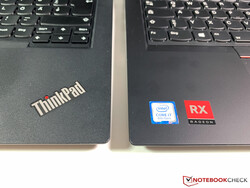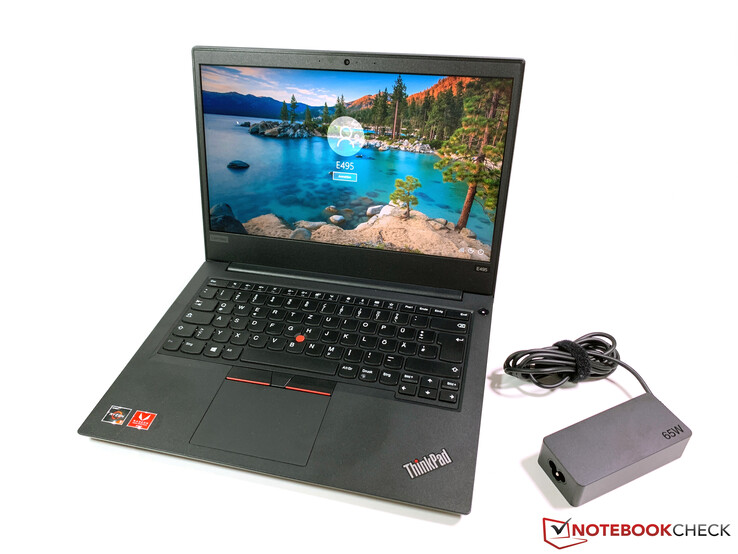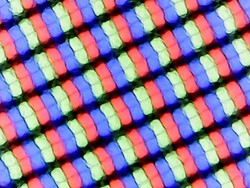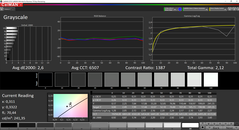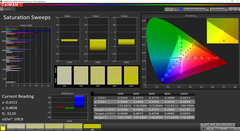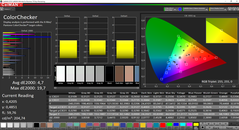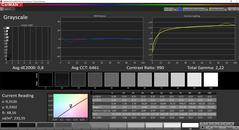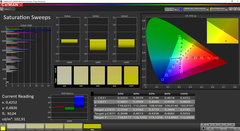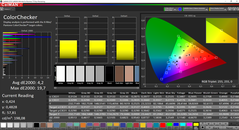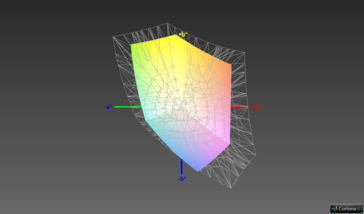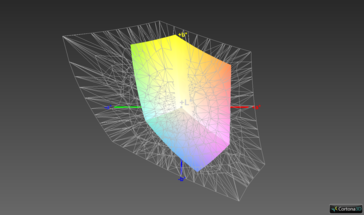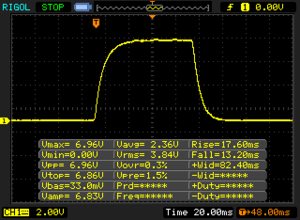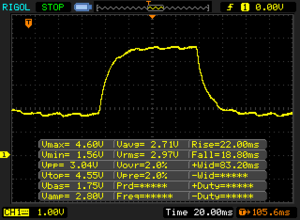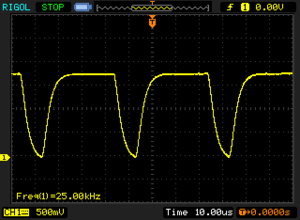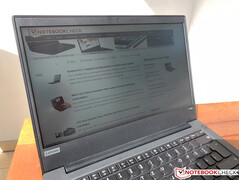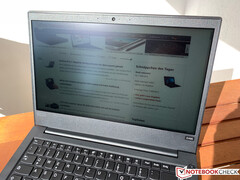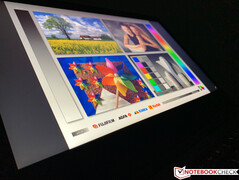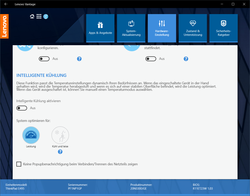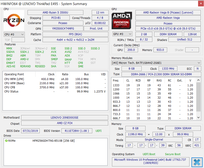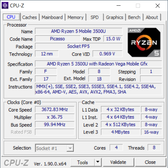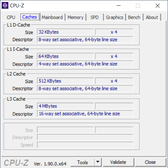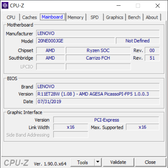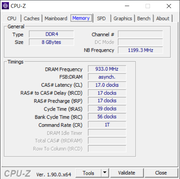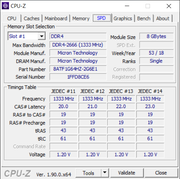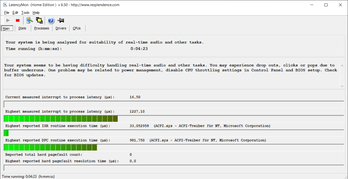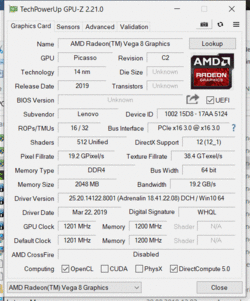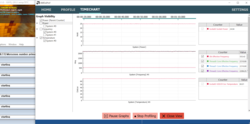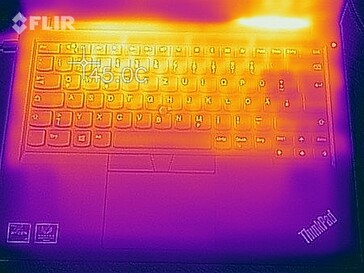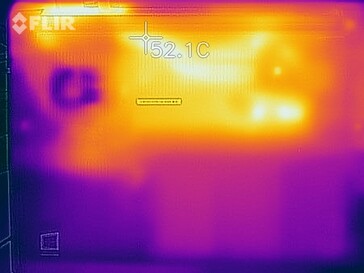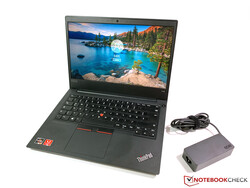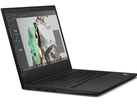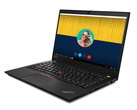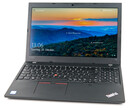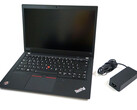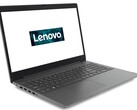Lenovo ThinkPad E495 Laptop Review: Inexpensive office device with a lot of power, but without keyboard illumination

In Lenovo's online shop, the starting price for the ThinkPad E495 is almost 100 Euros (~$110) higher than the E490 with an Intel processor, but its features are also worse. By contrast, a comparable model is around 40 Euros (~$44) more expensive. Our test model with the model number 20NE000JGE is relatively well equipped for 659 Euros (~$725), because instead of the 1-TB HDD (online store), there is a 256 GB NVMe SSD, which significantly speeds up the daily work. Those eligible for the corresponding campus model (20N000AGE, without Windows) only have to pay 529 Euros (~$582).
Basically, the case of the ThinkPad E495 corresponds to the Intel model E490, which is why we refer to our review of the ThinkPad E490 and the direct predecessor E485 for more information on the case, the equipment, the input devices and the speakers.
- Lenovo ThinkPad E490 laptop review
- Lenovo ThinkPad E485 laptop review
ThinkPad E490 & E495 Differences
Unfortunately, with the low-priced ThinkPad E-series, customers will have to make some sacrifices if they opt for the AMD-based model. The first difference, which one notices immediately, is the top surface of the base unit. It consists of much rougher and therefore cheaper-looking plastic. However, fingerprints are not as noticeable as with the "smoother" ThinkPad E490. The rest of the materials are identical.
Since the ThinkPad E495 is also a bit cheaper, you can certainly live with this difference. Nevertheless, what we cannot understand at all is the abandonment of a backlit keyboard; in contrast to the Intel model, this is not even available at extra cost. By the way, this also applies to the fingerprint scanner.
Furthermore, one would also have to forgo the advantages which the AMD SoC otherwise would offer, such as HDMI 2.0 and FreeSync.
| SD Card Reader | |
| average JPG Copy Test (av. of 3 runs) | |
| Lenovo ThinkPad E495-20NE000JGE (Toshiba Exceria Pro M501) | |
| Lenovo ThinkPad T495-20NKS01Y00 (Toshiba Exceria Pro M501 64 GB UHS-II) | |
| Lenovo ThinkPad E490-20N90004GE (Toshiba Exceria Pro M501) | |
| Lenovo ThinkPad E485-20KU000NGE (Toshiba Exceria Pro M501) | |
| Average of class Office (22.4 - 198.5, n=28, last 2 years) | |
| maximum AS SSD Seq Read Test (1GB) | |
| Lenovo ThinkPad T495-20NKS01Y00 (Toshiba Exceria Pro M501 64 GB UHS-II) | |
| Lenovo ThinkPad E495-20NE000JGE (Toshiba Exceria Pro M501) | |
| Lenovo ThinkPad E490-20N90004GE (Toshiba Exceria Pro M501) | |
| Lenovo ThinkPad E485-20KU000NGE (Toshiba Exceria Pro M501) | |
| Average of class Office (25 - 249, n=26, last 2 years) | |
Display – ThinkPad E495 with Matte IPS Panel
The ThinkPad E495 is offered in Germany only with a matte Full HD panel, which is based on the IPS technology. According to the data sheet, there is still an HD-TN display offered in other markets. However, one should avoid it in any case. Lenovo also uses panels from various suppliers (Innolux, BOE and AU-Optronics) in the production of the ThinkPad E495.
The manufacturer claims a brightness of 250 nits for our 1080p panel from Innolux (N140HCA-NCE), which we can confirm only at two measurement points. On average, there are only 230 nits. Thus, the AUO and BOE models in the E490 or last year's E485 perform better. The subjective impression is nevertheless good, because the contrast ratio is excellent at almost 1500:1. Screen bleeding is minimal at the bottom, which is only noticeable if the picture is completely black and has high brightness settings. This is not a problem in everyday office use.
| |||||||||||||||||||||||||
Brightness Distribution: 75 %
Center on Battery: 244 cd/m²
Contrast: 1418:1 (Black: 0.17 cd/m²)
ΔE ColorChecker Calman: 4.7 | ∀{0.5-29.43 Ø4.78}
calibrated: 4.2
ΔE Greyscale Calman: 2.6 | ∀{0.09-98 Ø5}
63.3% sRGB (Argyll 1.6.3 3D)
40.3% AdobeRGB 1998 (Argyll 1.6.3 3D)
43.8% AdobeRGB 1998 (Argyll 3D)
63.5% sRGB (Argyll 3D)
42.37% Display P3 (Argyll 3D)
Gamma: 2.12
CCT: 6507 K
| Lenovo ThinkPad E495-20NE000JGE N140HCA-EAC, , 1920x1080, 14" | Lenovo ThinkPad T495-20NKS01Y00 N140HCG-GQ2, , 1920x1080, 14" | Lenovo ThinkPad E490-20N90004GE B140HAN04.2, , 1920x1080, 14" | Lenovo ThinkPad E490-20N8000RGE Lenovo NV140FHM-N49, , 1920x1080, 14" | Lenovo ThinkPad E485-20KU000NGE B140HAN04.2, , 1920x1080, 14" | |
|---|---|---|---|---|---|
| Display | 57% | -8% | -7% | -8% | |
| Display P3 Coverage (%) | 42.37 | 67 58% | 38.98 -8% | 39.85 -6% | 39.21 -7% 38.48 -9% |
| sRGB Coverage (%) | 63.5 | 98.5 55% | 58.6 -8% | 58.6 -8% | 58.8 -7% 57.9 -9% |
| AdobeRGB 1998 Coverage (%) | 43.8 | 69.2 58% | 40.27 -8% | 41.18 -6% | 40.52 -7% 39.76 -9% |
| Response Times | 36% | -3% | -22% | -10% | |
| Response Time Grey 50% / Grey 80% * (ms) | 40.8 ? | 32.4 ? 21% | 44 ? -8% | 48.4 ? -19% | 44.8 ? -10% |
| Response Time Black / White * (ms) | 30.8 ? | 15.2 ? 51% | 30 ? 3% | 38.4 ? -25% | 33.6 ? -9% |
| PWM Frequency (Hz) | 25000 ? | 26040 ? | 1250 ? | ||
| Screen | 35% | -0% | 0% | -1% | |
| Brightness middle (cd/m²) | 241 | 420 74% | 278 15% | 305 27% | 289 20% |
| Brightness (cd/m²) | 230 | 391 70% | 257 12% | 295 28% | 271 18% |
| Brightness Distribution (%) | 75 | 88 17% | 85 13% | 90 20% | 87 16% |
| Black Level * (cd/m²) | 0.17 | 0.29 -71% | 0.19 -12% | 0.23 -35% | 0.19 -12% |
| Contrast (:1) | 1418 | 1448 2% | 1463 3% | 1326 -6% | 1521 7% |
| Colorchecker dE 2000 * | 4.7 | 2.1 55% | 5.1 -9% | 5.3 -13% | 5.6 -19% |
| Colorchecker dE 2000 max. * | 19.7 | 5.5 72% | 19.3 2% | 18.9 4% | 20.8 -6% |
| Colorchecker dE 2000 calibrated * | 4.2 | 0.7 83% | 4.5 -7% | 5 -19% | 4.7 -12% |
| Greyscale dE 2000 * | 2.6 | 3.4 -31% | 2.7 -4% | 2.3 12% | 2.7 -4% |
| Gamma | 2.12 104% | 2.22 99% | 2.21 100% | 2.09 105% | 1.96 112% |
| CCT | 6507 100% | 7168 91% | 6685 97% | 6246 104% | 6506 100% |
| Color Space (Percent of AdobeRGB 1998) (%) | 40.3 | 63.5 58% | 37.1 -8% | 37.7 -6% | 37.2 -8% |
| Color Space (Percent of sRGB) (%) | 63.3 | 98.6 56% | 58.4 -8% | 58.2 -8% | 58.5 -8% |
| Total Average (Program / Settings) | 43% /
39% | -4% /
-2% | -10% /
-4% | -6% /
-4% |
* ... smaller is better
Ex-factory, the display is already set pretty well, because there is no color cast and the color temperature is fine. In terms of color accuracy, however, the cheap IPS display can be obvious. Many colors are very inaccurate and exceed the target value (3) significantly, which cannot be corrected even with a calibration. In addition, the values for the color space coverage are low. This is certainly enough for the office, but the panel is not suitable for image editing.
Display Response Times
| ↔ Response Time Black to White | ||
|---|---|---|
| 30.8 ms ... rise ↗ and fall ↘ combined | ↗ 17.6 ms rise | |
| ↘ 13.2 ms fall | ||
| The screen shows slow response rates in our tests and will be unsatisfactory for gamers. In comparison, all tested devices range from 0.1 (minimum) to 240 (maximum) ms. » 83 % of all devices are better. This means that the measured response time is worse than the average of all tested devices (20.2 ms). | ||
| ↔ Response Time 50% Grey to 80% Grey | ||
| 40.8 ms ... rise ↗ and fall ↘ combined | ↗ 22 ms rise | |
| ↘ 18.8 ms fall | ||
| The screen shows slow response rates in our tests and will be unsatisfactory for gamers. In comparison, all tested devices range from 0.165 (minimum) to 636 (maximum) ms. » 63 % of all devices are better. This means that the measured response time is worse than the average of all tested devices (31.6 ms). | ||
Screen Flickering / PWM (Pulse-Width Modulation)
| Screen flickering / PWM detected | 25000 Hz | ≤ 40 % brightness setting | |
The display backlight flickers at 25000 Hz (worst case, e.g., utilizing PWM) Flickering detected at a brightness setting of 40 % and below. There should be no flickering or PWM above this brightness setting. The frequency of 25000 Hz is quite high, so most users sensitive to PWM should not notice any flickering. In comparison: 53 % of all tested devices do not use PWM to dim the display. If PWM was detected, an average of 8101 (minimum: 5 - maximum: 343500) Hz was measured. | |||
Performance – AMD ThinkPad Is Faster Than Intel Equivalent
The review unit came with a single-channel RAM configuration, so we test it that way. With another RAM module, however, the graphics performance of the Vega 8 can be increased even more. To compare with, we have included the ThinkPad T495, which comes with dual-channel RAM.
To take advantage of the full power, you have to disable Lenovo's "intelligent cooling" in the Vantage app, otherwise the power consumption of the processor is limited to 12 watts. The only advantage of this setting is that the fan does not start and the case temperatures remain very low. Our subsequent benchmarks were performed with this option disabled, thus representing the maximum performance of the ThinkPad E495.
Processor – ThinkPad with Ryzen 5 3500U
In the ThinkPad E series Lenovo relies on the "normal" Ryzen processors; Pro models are reserved for the more expensive ThinkPad T series. Our Ryzen 5 3500U is the direct competitor to the Intel Core i5-8265U, which is also used in the ThinkPad E490. For more technical details on the Ryzen SoC, please refer to our own CPU page.
The Intel CPUs are still ahead in terms of single-core performance, but as soon as you need multiple cores, the ThinkPad E495 is well ahead of the Core i5 in the ThinkPad E490. For the sake of a fair comparison, however, it should be noted that Lenovo allows a higher power consumption with the AMD processor. The customer has no influence on that though, and in the end you get more power with the E495 than with the E490. The 25W can also be managed by the cooling of the E495, which explains the good and consistent result in our Cinebench multi-loop. On battery power, the performance is not reduced.
System Performance – E495 with NVMe SSD
Thanks to the SSD and the fast processor, the subjective operating speed of the ThinkPad E495 is very high and we did not notice any problems during the test. However, you should pay particular attention when configuring the device in Lenovo's online shop, because the entry-level configurations are equipped with conventional HDDs. Although these offer more storage space, they slow down the machine noticeably.
| PCMark 10 Score | 3485 points | |
Help | ||
GPU Performance
With the Vega 8, the AMD Ryzen SoC offers a powerful integrated graphics unit, which is perfectly adequate for normal multimedia applications, including the playback of high-definition videos. Even Intel's integrated UHD Graphics 620 is clearly outperformed. To unlock the full potential of the Vega 8, however, another RAM module should be installed. The Vega 8 in the ThinkPad T495 (dual-channel RAM) is around 20-30% faster, depending on the benchmark. The fact that Lenovo does not include another RAM module is certainly due to the low price.
Also interesting is the comparison with the dedicated Radeon RX 550X, which is available for the ThinkPad E490 as well. It is about twice as fast, especially if you want to play games with the ThinkPad and is thus the better choice. With the Vega 8 you have to limit yourself to older or undemanding e-sports titles.
In the Fire Strike stress test of the current 3DMark, the ThinkPad E495 achieves 98%. Even under load for a prolonged period of time, the machine does not show any drops in performance. On battery power, GPU performance is not reduced.
| 3DMark 11 Performance | 3013 points | |
| 3DMark Fire Strike Score | 1639 points | |
Help | ||
| The Witcher 3 | |
| 1024x768 The Witcher 3 low | |
| Average of class Office (16 - 177, n=17, last 2 years) | |
| Average AMD Radeon RX Vega 8 (Ryzen 2000/3000) (22 - 50.7, n=18) | |
| 1366x768 The Witcher 3 medium | |
| Average of class Office (12 - 106.3, n=17, last 2 years) | |
| Average AMD Radeon RX Vega 8 (Ryzen 2000/3000) (16.3 - 33.8, n=10) | |
| 1920x1080 The Witcher 3 high | |
| Average of class Office (8.38 - 57.7, n=16, last 2 years) | |
| Average AMD Radeon RX Vega 8 (Ryzen 2000/3000) (6.7 - 18.3, n=14) | |
| 1920x1080 The Witcher 3 ultra | |
| Average of class Office (3.8 - 32.5, n=18, last 2 years) | |
| Average AMD Radeon RX Vega 8 (Ryzen 2000/3000) (4.44 - 10.1, n=7) | |
| low | med. | high | ultra | |
|---|---|---|---|---|
| BioShock Infinite (2013) | 81.9 | 14.3 | ||
| Dota 2 Reborn (2015) | 64 | 54.5 | 28.3 | 27.2 |
| X-Plane 11.11 (2018) | 23.8 | 17.3 | 15.2 |
Emissions
System Noise
All in all, the ThinkPad E495 is very quiet. When the load is low, the fan remains usually disabled. Even under load, only a quiet noise can be noticed. If you want to have the quietest possible laptop, you should enable Lenovo's "intelligent cooling". The performance is then reduced, but it is still enough for many normal operations. In this case the fan usually does not start at all. We were not able to hear any other disturbing noises (electronic noises, coil whine).
Noise level
| Idle |
| 29.3 / 29.3 / 29.3 dB(A) |
| Load |
| 32.8 / 34.5 dB(A) |
 | ||
30 dB silent 40 dB(A) audible 50 dB(A) loud |
||
min: | ||
Temperature
At low load levels, the bottom of the ThinkPad gets comparatively warm with values of more than 30 °C (86 °F), which is also due to the defensive fan control. However, this is not alarming or even annoying. In the stress test, we then measure temperatures of 43-44 °C (109.4-111.2 °F) on the top of the base unit and a maximum of 47-48 °C (116.6-118.4 °F) on the bottom. These values are not low for an office laptop, but the performance remains constant in this scenario as well. A 3DMark 11 run right after the stress test did not show any performance deficit.
(±) The maximum temperature on the upper side is 44.4 °C / 112 F, compared to the average of 34.3 °C / 94 F, ranging from 21.2 to 62.5 °C for the class Office.
(-) The bottom heats up to a maximum of 48.9 °C / 120 F, compared to the average of 36.8 °C / 98 F
(+) In idle usage, the average temperature for the upper side is 24.3 °C / 76 F, compared to the device average of 29.5 °C / 85 F.
(+) The palmrests and touchpad are cooler than skin temperature with a maximum of 29.4 °C / 84.9 F and are therefore cool to the touch.
(±) The average temperature of the palmrest area of similar devices was 27.6 °C / 81.7 F (-1.8 °C / -3.2 F).
Speakers
Lenovo ThinkPad E495-20NE000JGE audio analysis
(-) | not very loud speakers (70.4 dB)
Bass 100 - 315 Hz
(-) | nearly no bass - on average 15.9% lower than median
(±) | linearity of bass is average (11.7% delta to prev. frequency)
Mids 400 - 2000 Hz
(+) | balanced mids - only 3.6% away from median
(±) | linearity of mids is average (7.3% delta to prev. frequency)
Highs 2 - 16 kHz
(+) | balanced highs - only 1.9% away from median
(±) | linearity of highs is average (7.1% delta to prev. frequency)
Overall 100 - 16.000 Hz
(±) | linearity of overall sound is average (20.3% difference to median)
Compared to same class
» 43% of all tested devices in this class were better, 10% similar, 47% worse
» The best had a delta of 7%, average was 21%, worst was 53%
Compared to all devices tested
» 52% of all tested devices were better, 8% similar, 40% worse
» The best had a delta of 4%, average was 24%, worst was 134%
Power Management
Power Consumption
Especially in comparison with the predecessor ThinkPad E485 one can clearly see the efficiency improvement at low load levels. Here, the new ThinkPad E495 is much closer to the Intel based E490. In the stress test, we measured a maximum of 50 watts, which settles down in the course of the test at 41-42 watts and then remains stable. The included 65-watt power supply (USB-C, 345 grams/~12.2 oz) does not show any problems and has enough capacity to charge the battery under load.
| Off / Standby | |
| Idle | |
| Load |
|
Key:
min: | |
| Lenovo ThinkPad E495-20NE000JGE R5 3500U, Vega 8, SK hynix BC501 HFM256GDHTNG, IPS, 1920x1080, 14" | Lenovo ThinkPad T495-20NKS01Y00 R5 PRO 3500U, Vega 8, Samsung SSD PM981 MZVLB512HAJQ, IPS, 1920x1080, 14" | Lenovo ThinkPad E490-20N90004GE i7-8565U, Radeon RX 550X (Laptop), Toshiba KBG30ZMT512G, IPS, 1920x1080, 14" | Lenovo ThinkPad E490-20N8000RGE i5-8265U, UHD Graphics 620, SK hynix BC501 HFM256GDHTNG, IPS, 1920x1080, 14" | Lenovo ThinkPad E485-20KU000NGE R5 2500U, Vega 8, Samsung PM961 MZVLW256HEHP, IPS, 1920x1080, 14" | Average AMD Radeon RX Vega 8 (Ryzen 2000/3000) | Average of class Office | |
|---|---|---|---|---|---|---|---|
| Power Consumption | -25% | -67% | 10% | -33% | -33% | -30% | |
| Idle Minimum * (Watt) | 4.1 | 5.1 -24% | 6.8 -66% | 2.76 33% | 6.2 -51% | 5.68 ? -39% | 4.54 ? -11% |
| Idle Average * (Watt) | 5.86 | 7.7 -31% | 9.4 -60% | 5.96 -2% | 8.6 -47% | 8.75 ? -49% | 7.52 ? -28% |
| Idle Maximum * (Watt) | 6.36 | 10.7 -68% | 12.4 -95% | 6.57 -3% | 9.7 -53% | 10.1 ? -59% | 8.91 ? -40% |
| Load Average * (Watt) | 30.4 | 35.8 -18% | 57.2 -88% | 28.2 7% | 37.4 -23% | 37.8 ? -24% | 42.8 ? -41% |
| Load Maximum * (Watt) | 50 | 43.2 14% | 63.1 -26% | 43.6 13% | 44.8 10% | 46.2 ? 8% | 64.3 ? -29% |
* ... smaller is better
Battery Life
A major weakness of the old ThinkPad E485 was the battery life, which was significantly shorter than the Intel models. However, that changes with the new E495, because with the integrated 45 Wh battery, the AMD ThinkPad achieves realistic runtimes (WLAN, video) of around 8 hours. In the Wi-Fi test, it is thus on the level of the ThinkPad E490. Only in the video test was the Intel ThinkPad somewhat more endurable.
| Lenovo ThinkPad E495-20NE000JGE R5 3500U, Vega 8, 45 Wh | Lenovo ThinkPad T495-20NKS01Y00 R5 PRO 3500U, Vega 8, 50 Wh | Lenovo ThinkPad E490-20N90004GE i7-8565U, Radeon RX 550X (Laptop), 45 Wh | Lenovo ThinkPad E490-20N8000RGE i5-8265U, UHD Graphics 620, 45 Wh | Lenovo ThinkPad E485-20KU000NGE R5 2500U, Vega 8, 45 Wh | Average of class Office | |
|---|---|---|---|---|---|---|
| Battery runtime | 30% | -6% | 22% | -32% | 70% | |
| H.264 (h) | 7.9 | 11.8 49% | 8.2 4% | 11.5 46% | 5.7 -28% | 14.9 ? 89% |
| WiFi v1.3 (h) | 8.3 | 9.1 10% | 7 -16% | 8.1 -2% | 5.4 -35% | 12.5 ? 51% |
Pros
Cons
Verdict
The Lenovo ThinkPad E495 is a rock solid office laptop for little money. For under 700 Euros (~$770) you get a stable case, great input devices, a lot of power and a decent battery life. The comparison with the Intel model also shows that Lenovo artificially limits the E495 a bit. The plastic on the surface of the base unit looks much cheaper with its rough coating and we do not understand why there is no keyboard illumination or a fingerprint scanner not even at extra cost.
The performance of the Ryzen SoC is very good and both CPU and GPU score better than the Intel Core i5. However, the (optional) dedicated Radeon RX 550X in the ThinkPad E490 offers noticeably more graphics power and is therefore recommended if you also want to use the ThinkPad for gaming. Neither the E490 nor the E495 offer Thunderbolt 3, so connecting an eGPU is not possible. To exploit the full potential of the AMD SoC, you also need another RAM module.
Good value for money: The ThinkPad E495 offers more power than the slightly more expensive Intel model and has no longer any disadvantages in terms of battery life. However, one should be able to accept the lack of features (especially the keyboard illumination) and the cheaper plastic.
Please note: Since the review of the ThinkPad E490, we have updated our scoring system to version 7 (see here). This reduces the rating of the E490 from 89% to 86%. The ThinkPad E485 achieves 84%. The discrepancy, as we have listed in this article, results from the differences in the equipment and the case material.
Lenovo ThinkPad E495-20NE000JGE
- 09/16/2019 v7 (old)
Andreas Osthoff




